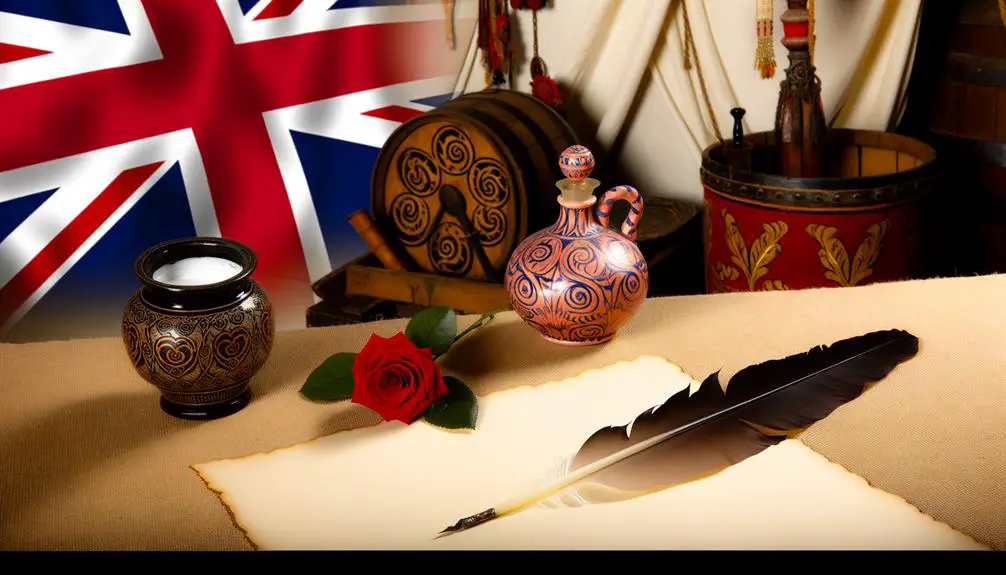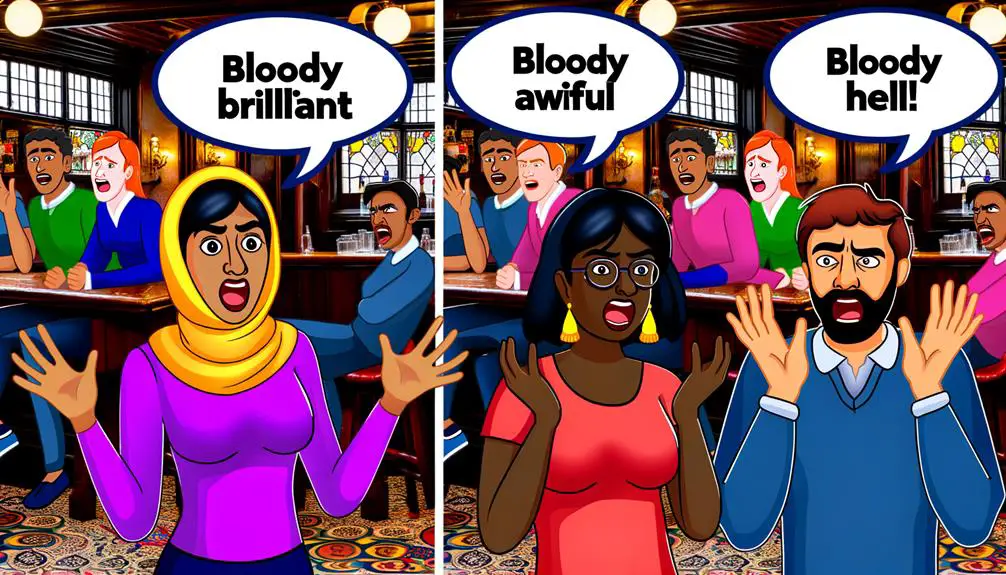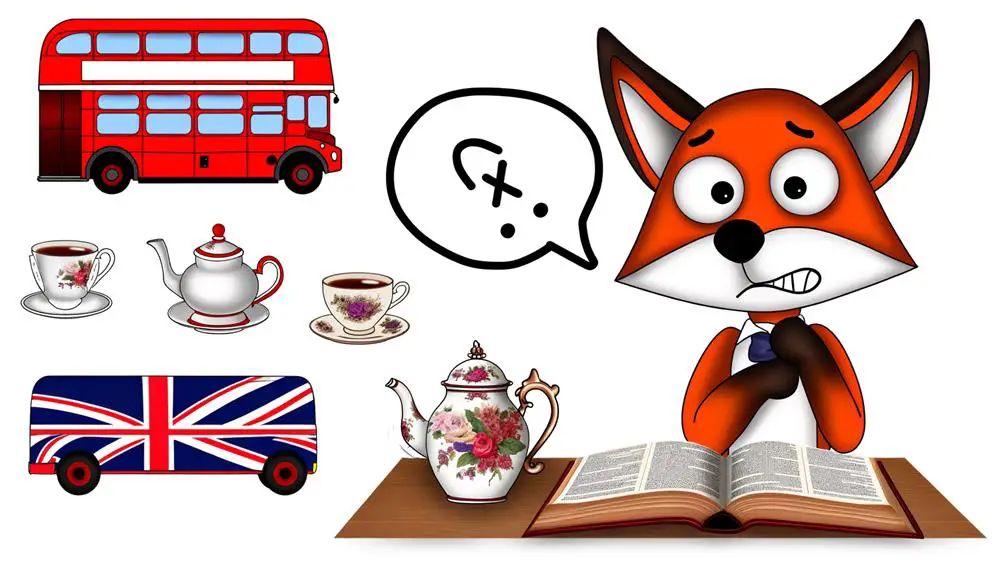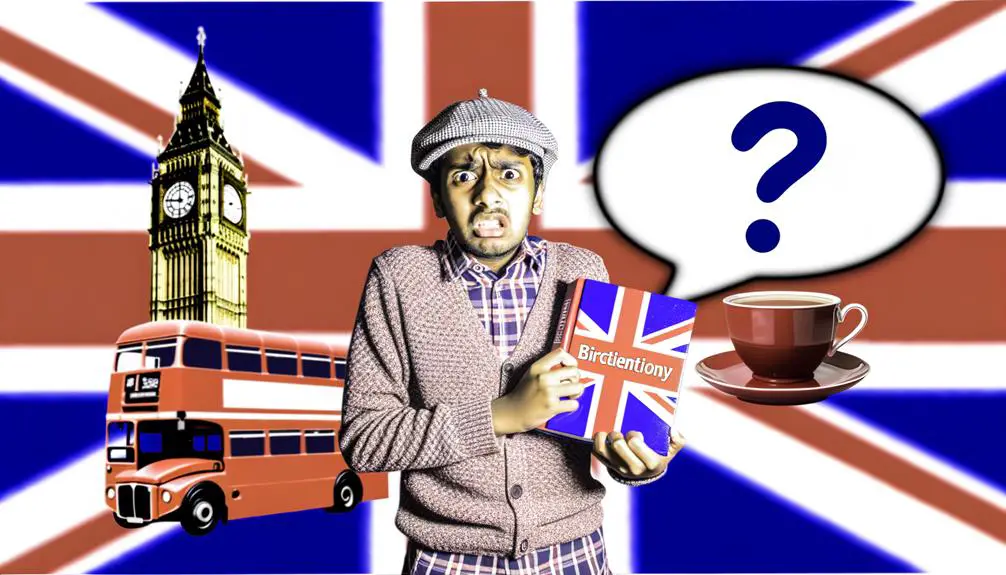In British slang, you'll find 'bloody' as a fascinating linguistic specimen that has shifted from a strong religious oath, likely rooted in 'by our lady,' to a milder intensifier and expletive. Its evolution showcases the fluidity of language, moving from blasphemy to a widely acceptable term. It serves as an emotional amplifier, adding emphasis and conveying a spectrum of feelings from annoyance to intense frustration, depending on its placement in a sentence. The term's versatility in intensifying adjectives and nouns underlines its significance in emotional expression. Mastering its use involves understanding its historical context, nuances, and the subtle shifts in acceptability and pronunciation over time, laying the groundwork for further exploration into this rich linguistic domain.
Key Takeaways
- 'Bloody' is a versatile expletive in British slang, often used as an intensifier to convey strong emotions.
- Originally a profound oath, its meaning has softened over time, making it less taboo and more commonly used.
- It can amplify the sentiment of a statement, ranging from mild annoyance to intense frustration.
- The term can modify both nouns and verbs, similar to 'very' or 'really,' for added emphasis in a sentence.
- Understanding its usage involves recognizing cultural nuances and the emotional weight it carries in different contexts.
Origins of "Bloody"

The term 'bloody' has a rich and complex history, tracing back to early English society where it was likely derived from the phrase 'by our lady,' signifying a strong oath connected to religious references. This origin theory, deeply embedded in linguistic roots, provides a fascinating glimpse into the etymology debate surrounding this word. As you explore further into its origins, you'll find that the word's evolution over centuries is a reflection of the fluid nature of language.
Scholars in the field of linguistics have long engaged in the etymology debate, examining various sources and historical documents to trace the development of 'bloody.' The consensus leans towards its initial usage as a profane expression of surprise or emphasis, closely tied to religious blasphemy. This perspective is supported by etymological studies that highlight the progression of language within socio-religious contexts.
Understanding the linguistic roots of 'bloody' involves dissecting the layers of language development and societal influences that have shaped its meaning. It's a journey through the annals of linguistic history, where each finding contributes to a broader understanding of how words capture the essence of the times.
Evolution Over Time
As 'bloody' evolved through the ages, its significance morphed remarkably, reflecting broader shifts in societal norms and linguistic practices. This transformation is not only a demonstration to the dynamic nature of language but also highlights the intricate process of linguistic adaptation and phonetic changes that 'bloody' has undergone.
To understand this evolution, let's examine the changes in three key aspects: meaning, phonetics, and acceptability.
| Aspect | Early Usage | Mid-Era Changes | Modern Interpretation |
|---|---|---|---|
| Meaning | Strongly profane or blasphemous | Less offensive, more emphasis | Mild expletive, intensifier |
| Phonetic Changes | Pronounced with more weight on vowels | Shift towards a faster, clipped delivery | Smooth, almost seamless inclusion in speech |
| Acceptability | Highly taboo, restricted usage | Gradual acceptance in literature and speech | Widespread use, diminished shock value |
This table encapsulates the linguistic journey of 'bloody', from its roots as a potent term laden with religious blasphemy to its current status as a versatile, albeit milder, slang term. The trajectory of 'bloody' mirrors the linguistic adaptation characteristic of living languages, illustrating how phonetic changes and shifting societal attitudes towards language and its functions sculpt the lexicon across time.
Common Usage and Examples

In contemporary discourse, 'bloody' serves as a linguistic chameleon, adapting its meaning and intensity to the context in which it's uttered, thereby showcasing its versatility and enduring relevance in English vernacular. Its usage spans a spectrum, from mild annoyance to intense frustration, dictated largely by importance factors and grammatical placement. You'll find that its placement within a sentence can greatly alter the conveyed emotion or emphasis, a proof to its flexibility as a modifier.
When nestled within an adjectival phrase, 'bloody' can intensify the characteristic being described. For example, 'It's a bloody shame,' escalates the sentiment of regret or disappointment. Here, significance factors play a critical role; the speaker balances the desire to express strong emotion with the need to adhere to social norms of respectability and restraint. Similarly, when used as a precursor to a noun, it can both elevate the subject's importance and the speaker's emotional investment, as in 'That was a bloody brilliant performance.'
Analyzing these examples, it's clear that 'bloody' occupies a unique position in English slang. Its grammatical placement and the surrounding significance factors not only enrich the language but also offer nuanced ways for speakers to navigate the complexities of emotional expression and social interaction.
Emotional Amplifier
You'll find that 'bloody' serves as an emotional amplifier in British slang, marking a significant intensity level indicator within verbal exchanges. Its function as an expressive language tool allows speakers to convey a wide spectrum of emotions, from sheer frustration to overwhelming excitement, with nuanced effectiveness. This multifaceted usage underscores its importance in both casual conversations and more heated discourses, illustrating the complexity and depth of British slang.
Intensity Level Indicator
The term 'bloody' often serves as an emotional amplifier in British slang, greatly intensifying the sentiment of the statement it accompanies. Its effectiveness as an intensity level indicator can be attributed to the inherent color significance and medical interpretations tethered to the word. Historically, 'bloody' conjures images of battle and violence, evoking a visceral response. This association leverages deep-seated psychological reactions to the color red, symbolizing danger, passion, and urgency, which, when applied linguistically, enhances the expressive power of the term. Medical interpretations further augment this intensity, as 'bloody' can allude to life's fragility and the primal fear of injury or death, thereby magnifying the emotional weight of the discourse.
Expressive Language Tool
Beyond serving as merely an intensifier, 'bloody' acts as a potent expressive language tool, empowering speakers to amplify their emotional state with precision and depth. This function within linguistic diversity and cultural perceptions highlights its significance in communication. Specifically, it showcases:
- The ability to convey a wide range of emotions, from frustration to excitement, without altering the base meaning of the sentence.
- A reflection of cultural perceptions, where its use can denote informality or strong emotional resonance within specific contexts.
- The role in linguistic diversity, serving as a bridge between colloquial expressions and formal language, allowing speakers to navigate social nuances effectively.
In essence, 'bloody' enriches dialogue, providing speakers with a versatile tool to express emotions vividly, reflecting the complexities of human communication and cultural identity.
Variations and Related Phrases

Investigating the variations and related phrases of 'bloody' exposes a rich tapestry of linguistic evolution within British slang, showcasing both cultural subtleties and historical shifts. You'll find that accent influence plays a significant role in how 'bloody' is adapted and utilized across different regions, even though this discussion strictly avoids delving into regional differences. For instance, the pronunciation and emphasis on 'bloody' can vary, altering its impact and perceived intensity. This phenomenon intricately ties into the politeness spectrum, where 'bloody' oscillates between being a mild expletive to a stronger form of expression depending on the speaker's accent and the context in which it is used.
The adaptation of 'bloody' has given rise to a plethora of related phrases and variations, each carrying its unique shade of meaning and usage. Phrases like 'bloody hell' or 'bloody brilliant' serve to intensify the emotion or opinion being expressed, illustrating the word's flexibility and depth as an expressive tool. This flexibility maintains 'bloody' as a staple in the lexicon of British slang, continually reflecting the dynamic nature of language as influenced by societal norms, attitudes, and trends.
Regional Differences
While exploring the nuances of 'bloody' across the United Kingdom, it becomes evident that regional differences deeply shape its use and interpretation, revealing a complex interplay between language, identity, and culture. The term's adaptability and its resonance within varying cultural perceptions are remarkable. Accent influence plays a significant role in how the word is perceived and can drastically alter its impact.
Consider these key points:
- Cultural perceptions: In some regions, 'bloody' is almost a term of endearment or a staple of everyday language, whereas, in others, it retains a stronger, more controversial edge.
- Accent influence: The way 'bloody' is articulated can either soften its delivery or amplify its perceived severity. For instance, the rounded vowels in Northern accents may lend a less harsh sound to the word compared to the sharper enunciation found in some Southern regions.
- Frequency of use: Urban versus rural settings might see a variance in the frequency and context of 'bloody,' reflecting differing attitudes towards slang and informal language usage.
Understanding these regional differences underscores the importance of context in language. 'Bloody,' far from being a monolithic term, is a linguistic chameleon, adapting its shades of meaning according to the cultural and geographical landscapes of the UK.
Controversies and Censorship

Exploring the regional nuances of 'bloody' illuminates its complex role within British culture; however, the word's journey through controversies and censorship further reveals the intricate balance between language evolution and societal norms. The controversies surrounding 'bloody' have often stemmed from its perceived offensiveness, leading to notable legal implications and debates over advertising standards. Historically, the use of 'bloody' in public discourse and media was met with stringent censorship, reflecting broader societal taboos surrounding language deemed inappropriate or vulgar.
The legal implications of using 'bloody' in advertising and broadcasting have underscored the tension between freedom of expression and the desire to maintain public decency. Regulatory bodies have grappled with setting clear boundaries, often leading to inconsistency in how 'bloody' is treated across different media platforms. This inconsistency highlights the subjective nature of what is considered offensive, further complicating the word's status within British slang.
Moreover, the role of advertising standards in policing the use of 'bloody' illustrates the ongoing negotiation between linguistic expression and commercial considerations. Advertisers seeking to push boundaries for impact have occasionally clashed with standards designed to protect the public from potentially offensive material, thereby igniting debates over the limits of creative freedom versus societal responsibility.
Bloody in Popular Culture
The widespread influence of 'bloody' in popular culture has greatly shaped its reception and usage within the broader public sphere, illustrating a dynamic interplay between linguistic evolution and societal values. This term, deeply embedded in the fabric of British slang, has transcended its origins to become a staple in various forms of media, profoundly impacting its perception and acceptance.
- Film Adaptations: The incorporation of 'bloody' in film adaptations of classic British literature and modern cinematic endeavors has played a pivotal role in normalizing the term. These adaptations often seek authenticity in dialogue, leading to a natural integration of the slang. This not only preserves the cultural context but also enhances the global understanding of British colloquialisms.
- Celebrity Influences: Public figures and celebrities wielding considerable influence have further propelled the use of 'bloody' into the limelight. Their casual deployment of the term in interviews, social media, and public appearances has contributed to its desensitization and acceptance, particularly among younger audiences who emulate these figures.
- Music and Literature: The presence of 'bloody' in British music lyrics and literature serves not only as a reflection of societal attitudes but also as a vehicle for cultural expression and identity. This usage underscores the term's versatility and enduring relevance in capturing the essence of Britishness.
Through these channels, 'bloody' continues to evolve, mirroring shifts in societal norms and values while reinforcing its position in the lexicon of popular culture.
Misconceptions Debunked

You may have misconceptions about the term 'bloody' being inherently vulgar; however, its offensiveness is not a constant but varies widely with context. Historically, 'bloody' has traversed a fascinating path, once deemed profane, yet its usage over time reveals a fluidity in acceptability and meaning. Understanding this evolution is important, as the context in which 'bloody' is employed dramatically influences its perceived appropriateness and impact.
Not Always Vulgar
Contrary to popular belief, the term 'bloody' in British slang isn't always considered vulgar, but rather can serve as a versatile intensifier with historical roots deeply embedded in the linguistic fabric of the UK. This misconception often arises from differing cultural perceptions of swearing and politeness. Analyzing this from an etiquette perspective reveals a nuanced understanding of its usage across various contexts.
- Swearing alternatives: 'Bloody' acts as a milder option compared to harsher swear words, fitting into casual conversations without causing offense.
- Etiquette perspectives: In many social settings, it's seen as acceptable, reflecting a speaker's emotion without crossing boundaries of decorum.
- Linguistic adaptability: Its flexibility allows for emphasis without resorting to stronger language, demonstrating the dynamic nature of British slang.
Historical Usage Explained
Delving into its historical origins, we discover that 'bloody' has been a part of English vernacular far longer than commonly believed, shedding light on widespread misconceptions about its usage and perceived vulgarity. Initially, its use carried significant religious connotations, hinting at the 'blood of Christ' or the violence of His crucifixion. This association imbued the term with a gravity that transcended mere expletive status, weaving it into the fabric of religious and cultural discourse. Moreover, the legal implications of uttering 'bloody' were historically severe, reflecting societal attitudes towards blasphemy and the sacred. Courts once deliberated on its utterance with utmost seriousness, indicative of its potent symbolic weight in public morality and law. This historical depth complicates the modern perception of 'bloody' as merely vulgar slang, revealing layers of cultural resonance and legal caution.
Contextual Meaning Matters
While it's clear that the term 'bloody' has roots deeply embedded in religious and legal history, understanding its context reveals a nuanced spectrum of meaning that challenges common misconceptions. This exploration necessitates a scholarly approach, dissecting the term's usage within various social settings and its evolution over time.
- Grammar rules play a pivotal role in discerning its derogatory from its emphatic uses.
- Reveal tips can disclose subtle distinctions, offering clues to the speaker's intent.
- Misinterpretations often arise from neglecting the linguistic and cultural backdrop against which 'bloody' is employed.
Learning to Use "Bloody" Correctly

To effectively incorporate the term 'bloody' into your vocabulary, it is important to grasp its nuanced meanings and contexts within British slang. Understanding both the grammar rules and pronunciation guide surrounding its usage is essential for non-native speakers aiming for authenticity in their speech. 'Bloody' functions as an intensifier, akin to 'very' or 'really', but with a distinctly British flair. Its placement within a sentence follows traditional adjectival and adverbial usage, modifying nouns and verbs for emphasis. For example, 'It's bloody cold today,' demonstrates its role as an adverb enhancing the adjective 'cold'.
Pronunciation also bears significance, as the strength of the accent can alter the word's impact. The British pronunciation leans towards a softer 'd', almost as if it's a gentle tap of the tongue against the upper teeth, blending seamlessly into the following syllable. This subtlety contrasts with the harsher enunciations found in other dialects, which can inadvertently alter the word's perceived intensity or even its acceptability in casual conversation.
Mastering the application of 'bloody' requires a delicate balance between linguistic precision and cultural sensitivity, ensuring that its use enriches communication rather than detracts from it.







